By Stan Wise
PIERRE, SD – Agricultural producers often base their land management decisions on the living things they can see above the ground – crops, livestock, forage, weeds, insects, wildlife, etc. However, new research is showing they should also consider life found in the soil.
“Fifty percent of the diversity in the globe is in the soil. Soil is biology,” U.S. Department of Agriculture Agricultural Research Service Soil Microbiologist Michael Lehman said. That biology – microorganisms and other soil fauna – plays an important role in the production of food, fiber, and fuel.
“Without microbes, there’s no life, period,” Lehman said. “They sustain global biogeochemical processes, which are the foundation for all other life.”
USDA-ARS Soil Microbiologist Chuntao Yin, Lehman’s colleague at the USDA-ARS North Central Agricultural Research Laboratory in Brookings, SD, explained some of the numerous benefits soil biology provides to producers.
“They break down crop residue, release the nutrients into the soil, and build soil health,” Yin said. “They can suppress disease and improve soil structure. They can mitigate climate change, like consume greenhouse gases.”
Research conducted by Lehman and Yin shows that land management decisions affect the health and diversity of soil biological communities. These communities are, in turn, linked to aspects of improved crop and forage production.
Soil structure
Healthy soil structure is critical for sustainable agricultural production. That structure is formed of small soil aggregates held together by substances secreted by soil biology.
“For example, bacteria can secrete some extracellular polysaccharides. It’s like glue. They can bind the soil together,” Yin said. “Most multicellular fungi are made of hyphae. It’s like a network. They also combine the soil.”
The spaces between these aggregates allow air and water to infiltrate the soil.
“It does mean storing more water. It does mean less water running off the fields. But really importantly is it maintains the flow of oxygen as well as water to the plants and to the microbes so they can maintain their level of activities and mineralize nutrients that are available or make them available for uptake by the crop,” Lehman said. “Having good soil structure and good water and air infiltration is pretty much everything for the microbes and the plants to thrive.”
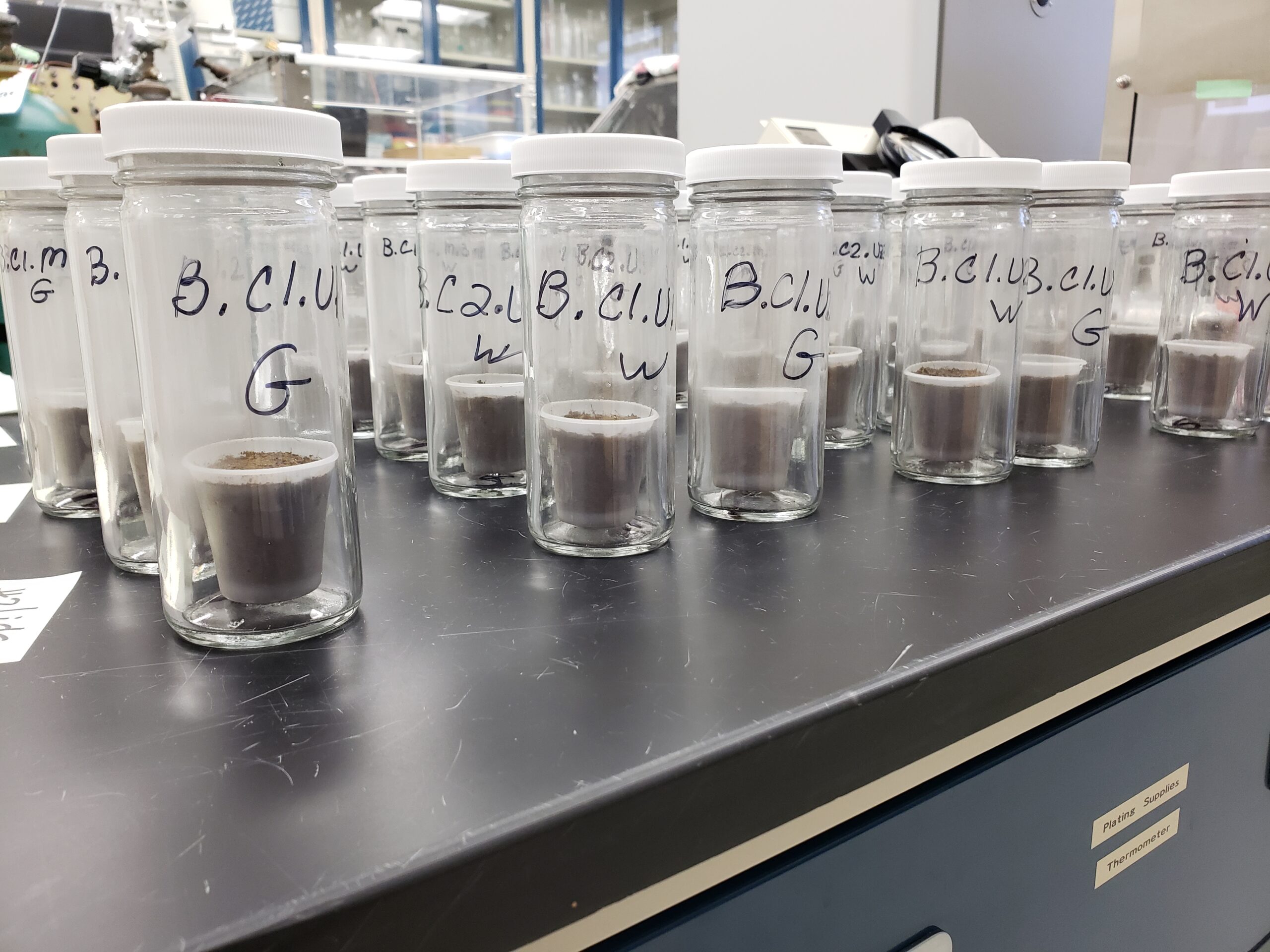
Researchers at the USDA-ARS North Central Agricultural Research Laboratory in Brookings, SD, use these airtight jars to measure respiration from living organisms in the soil. USDA-ARS photo.
Lehman’s research compared short-term carbon mineralization (which is an indicator of soil biological activity) with erodible soil fraction (which is a measure of soil structure) in a two-year corn and soybean crop rotation and different four-year crop rotations that include corn and soybean. In all the samples, he found a direct relationship between soil biological activity and soil structure.
“If you have high carbon mineralization activities, you have a low erodible soil fraction, which is good,” Lehman said. “So, we directly relate the activities of microbes to the aggregation of the soils, and even more so we implicate the management because the samples that have really high erodible fraction were all taken from the plots where corn or soybean followed each other.”
So, producers can promote healthy soil biology by planting diverse crop rotations. That biology will, over time, form the healthy soil structure needed for sustainable crop production.
Yield
Lehman and Yin also found that producers should consider the soil microbial community when planning their crop rotations because those communities are associated with crop yield.
In a two-year study, Lehman and other researchers looked at the biomass of corn at both the seedling and tasseling stages in several different crop rotations. Higher biomass is an indicator of higher yield. They found that corn had the lowest biomass when it followed soybeans and the highest biomass when it followed peas or sunflowers.
The researchers also studied the microbial communities that colonized the thin layer of soil surrounding the plant roots and found surprising results.
“When we look at that community, we find out the distinctive fungal taxa after soybean are our probable plant pathogens, whereas the fungal community after peas and sunflower tends to have more beneficial fungi like mycorrhizae,” Lehman said.
Yin’s research also discovered a link between soil biology and crop yields. She participated in a study that compared spring wheat yields following winter wheat, winter canola, winter triticale and spring wheat. The researchers found that spring wheat yields were significantly lower when following winter canola. When they studied the soil microbiome, they noticed the samples following winter canola had distinctive microbial communities.
“For example, the mycorrhizal fungi are dramatically decreased, but some fungal pathogens are significantly increased,” Yin said. “The takeaway message for this study is microbial legacy is a very important consideration to design the crop rotation.”
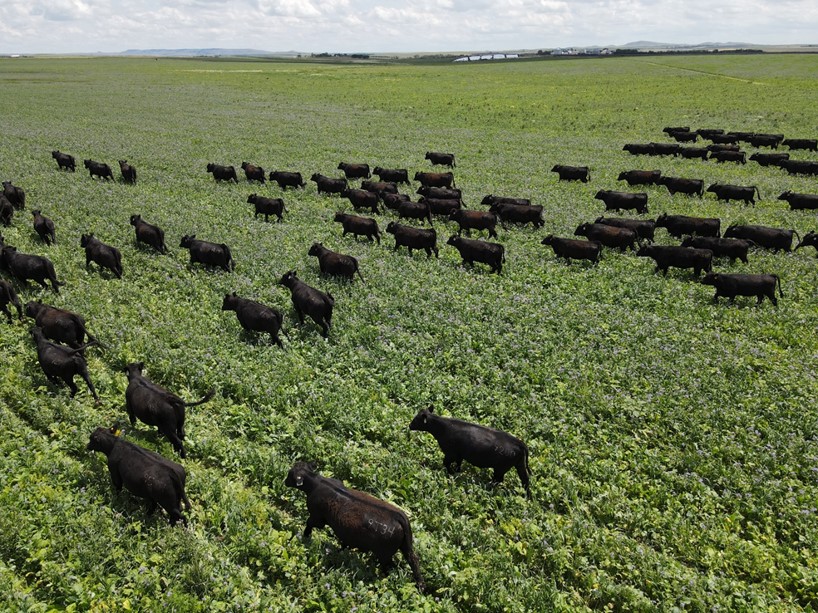
Jorgensen Land and Cattle near Ideal, SD, grazes cattle on about 40-45% of its cropland. Nick Jorgensen said that grazing cattle improves his crop yields and adds about 25% more soil organic matter per year when compared to the cropland he can’t graze. Courtesy photo.
Other important connections
Research also ties other benefits to diverse crop rotations and healthy, diverse soil biology, including reduced greenhouse gas emissions, carbon sequestration, and more.
“We’ve reduced the activity of organisms that produce nitrous oxide, and we’ve done that simply by management with a diversified rotation. We also saw in all those plots soil carbon accrual,” Lehman said. “The more diverse the rotation, we were getting changes in the microbial community activities and that resulted in carbon sequestration.”
That carbon accrual comes in the form of increased soil organic matter, which improves water storage capacities and increases soil fertility. “If you increase soil organic matter, you are almost surely going to increase soil organic nitrogen as well,” Lehman said.
Yin’s research showed that a type of soil bacteria behaves as an inhibitor to a fungus that causes root rot in wheat and that the introduction of that bacteria to pathogen-infested soils improved plant growth.
She also said that she knew of research showing that certain types of soil fungi use weeds as hosts and that those fungi can reduce weed pressure in fields.
Another study Lehman participated in showed that soils in rangelands managed with rotational grazing systems had a higher microbial and fungal biomass than conventionally grazed soils.
“This is linked with higher amounts of plant biomass on these grazing lands and higher amounts of soil organic carbon and soil organic nitrogen,” Lehman said.
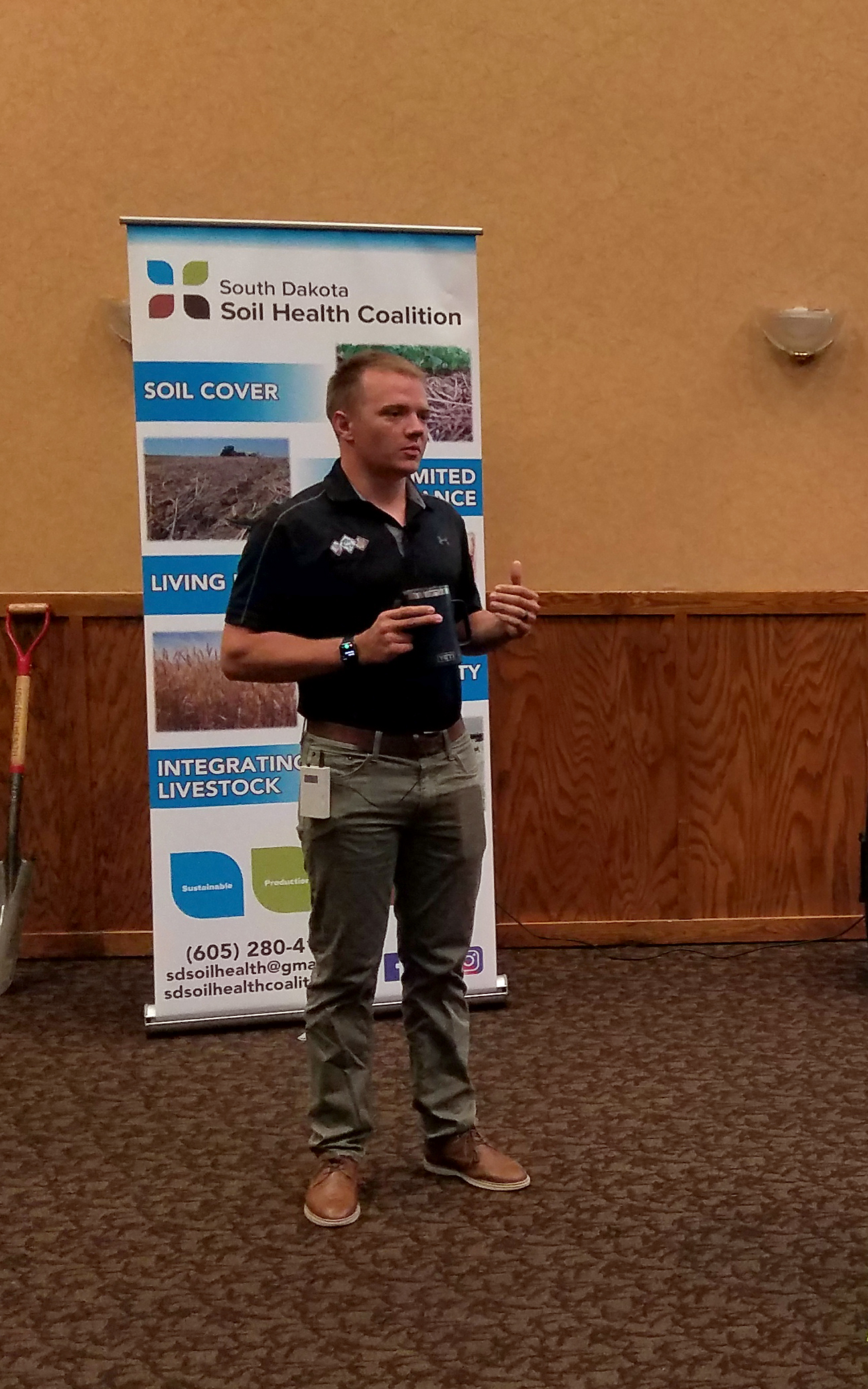
Nick Jorgensen, CEO of Jorgensen Land and Cattle near Ideal, SD, explained the economic benefits of soil health practices during the 2021 Soil Health School. SD Soil Health Coalition photo.
Making it work
Lehman said the best way to promote healthy soil biology is to follow the guidelines outlined by the Natural Resources Conservation Service and the principles of soil health. Those principles are keeping soil covered with plant residue, minimizing soil disturbance, keeping a living root in the soil, increasing biodiversity, and incorporating livestock.
Nick Jorgensen, CEO of Jorgensen Land and Cattle, near Ideal, SD, said that his family’s 26,000-acre operation incorporates all five soil health principles on as many acres as possible.
The Jorgensens have been using no-till practices for 32 years, and they implement a diverse 5- to 7-year crop rotation which includes cover crops on their 13,000 acres of cropland. They maintain good residue cover on all their land. Jorgensen said that 40-45% of their cropland has fencing and water facilities, so they graze residue, cover crops, and forage crops on those acres.
“One of the things about livestock is when they’re out there, they are actively transplanting microbiology,” Jorgensen said. “We have seen in several cases pretty uniformly higher yields where we can graze cattle on that farmland.”
In 2012 Lehman published research conducted at Jorgensen Land and Cattle that showed higher arbuscular mycorrhizal fungi populations in fields that were seeded with cover crops after summer-harvested small grains compared to adjoining fields without cover crops. While Jorgensen hasn’t conducted his own close study of his soil microbial communities, he knows his soil health practices are resulting in the benefits outlined by Lehman and Yin’s research.
“We have phenomenal water infiltration rates,” Jorgensen said. “We’re adding about a quarter percent of soil organic matter across the board in our operation per year. In our operation it nets out to about 15,000 tons of soil carbon that we’re sequestering every year because of the practices that we’re doing.”
Jorgensen attributes this sequestration to active soil microbes.
“Why is that happening? It’s happening because we’re leaving residue there,” Jorgensen said. “What breaks down residue? Soil microbiology takes it from the top of the soil and incorporates it as organic matter into the soil. So, it makes complete sense to me that we would be seeing soil carbon go up because of more residue on the ground and higher populations of soil microbiology.”
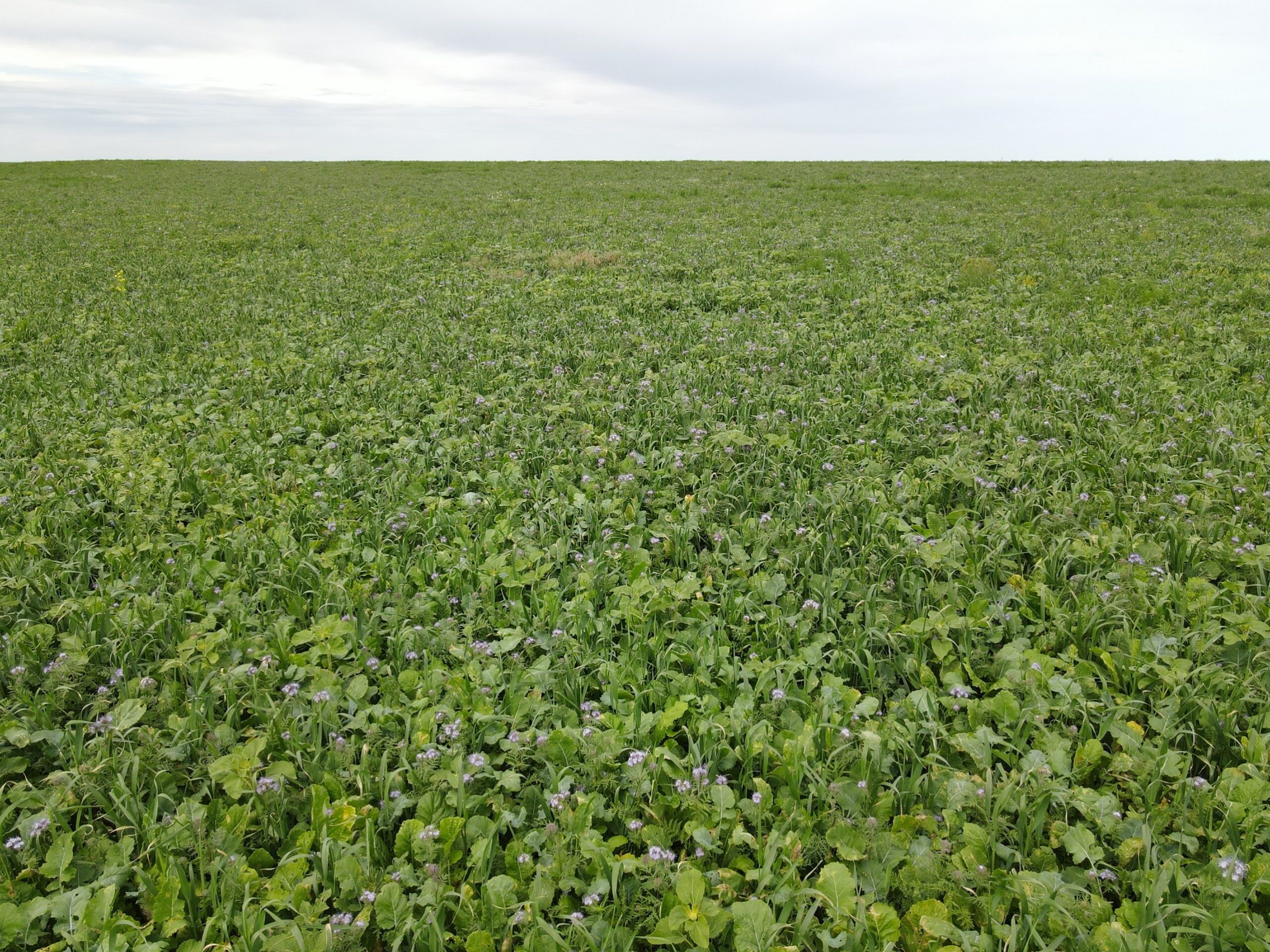
Jorgensen Land and Cattle near Ideal, SD, includes a cover crop like this one in its 5- to 7-year crop rotation. The cover crop reduces weed pressure, provides additional forage for cattle, and helps grow the soil microbial community. Courtesy photo.
Jorgensen said that his operation has very few problems with disease and rarely uses insecticide. He also has drastically reduced weed populations in years following a cover crop.
All of these benefits work to keep his input costs low.
“We’re actively managing this entire operation, whatever crop goes in the ground, in an extremely low fertility program,” Jorgensen said. “Corn or winter wheat, it might only get 70 units of nitrogen in the entire lifecycle of that crop.”
The reduced input costs help keep his operation profitable.
“Our total cost on a bushel of corn on a year like this is going to be sub-three dollars,” Jorgensen said. “It enables us to be real cost competitive.”
Lehman said the key lesson from his and Yin’s research is that land management practices to promote healthy soil biology can improve agricultural operations.
“If I was a producer, what I would want to know is that my management makes a difference,” he said. “It makes a difference in all these things they can’t see, but it also makes a difference in the yield and the sustainability and the resilience of those systems.”
To learn more about soil health practices, visit www.sdsoilhealthcoalition.org. For guidance and assistance on implementing sustainable land management practices, producers and landowners can visit their local NRCS office or contact the South Dakota Soil Health Coalition at 605-280-4190.
Download a printer-friendly version of this article here.
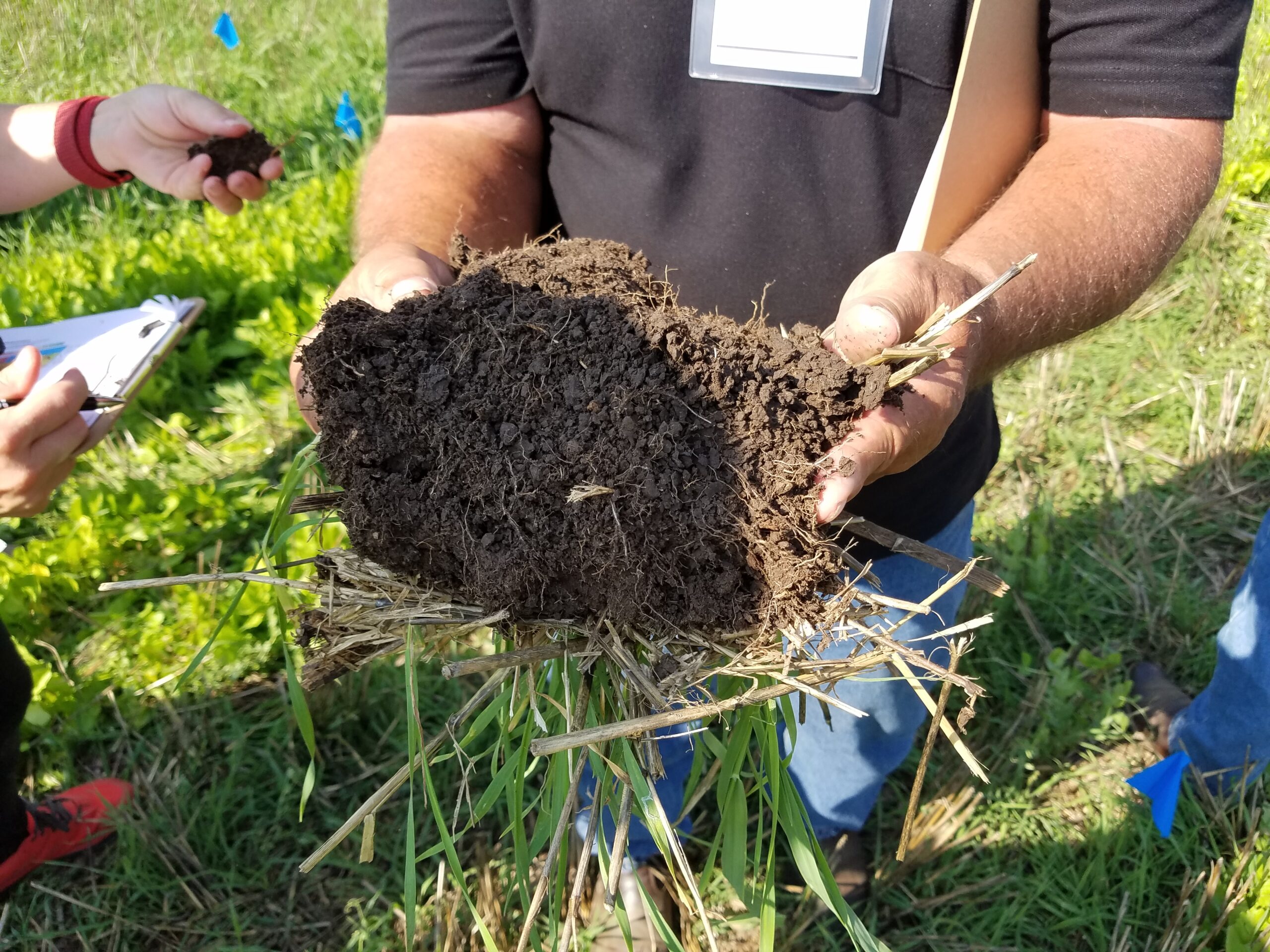
Healthy soil structure is critical for sustainable agricultural production. That structure is formed of small soil aggregates held together by substances secreted by soil biology. The spaces between these aggregates allow air and water to infiltrate the soil. SD Soil Health Coalition photo.
0 Comments